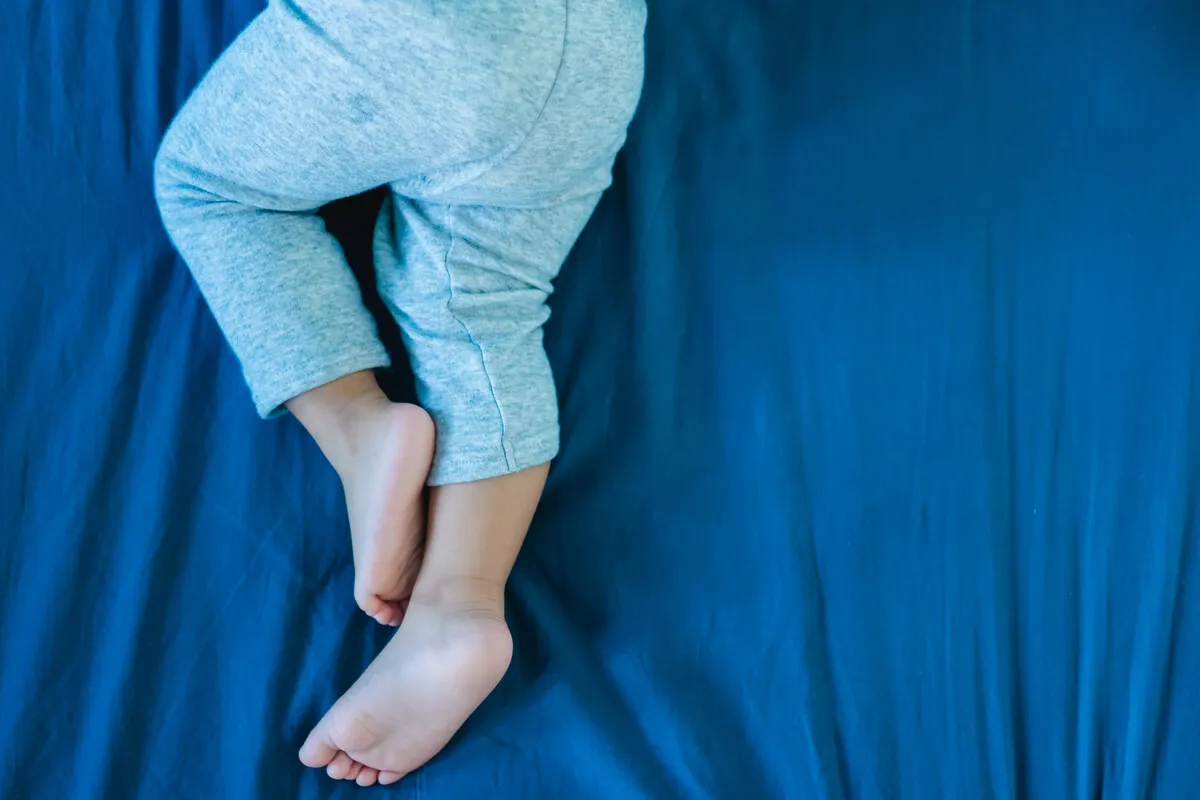Resting Leg Pain: 7 Possible Causes and What to Do for Relief


Reviewed and approved by the nurse Leidy Mora Molina
Leg pain is a common reason for medical consultation worldwide. It can appear while people are resting in bed or on the sofa, and even after physical activity. Are you interested in knowing what causes leg pain at rest? We’ll tell you in this article.
The legs are made up of a wide variety of muscles, ligaments, tendons, nerves, and blood vessels. They’re responsible for supporting the body and allowing movement. In this sense, leg pain at rest can be the result of damage or affection of any of these anatomical structures.
In general, poor circulation, nerve compression, and varicose veins are frequent causes of discomfort in the lower limbs. In most cases, the ailments appear after several hours of lying down or with the legs elevated. Early professional evaluation helps to progressively reduce symptoms.
Causes of leg pain at rest
Leg pain at rest can be localized or spread along the entire limb. It often begins as a cramping or heavy sensation that increases in intensity over time. In addition, it’s often accompanied by other symptoms that facilitate the identification of the underlying disease or condition. Here are some of the most common possible causes.
1. Peripheral arterial disease
Impaired blood flow is one of the most common causes of leg pain at rest. In peripheral arterial disease, there’s an imbalance between blood supply and demand in the extremities. This condition usually results from the narrowing of the blood vessels by fatty plaque.
People with vascular conditions often experience cramping in their calves and ankles when walking. In advanced cases, the pain usually intensifies and appears even when the legs are at rest. Other symptoms associated with blood flow obstruction include the following:
- Numbness and weakness in the legs
- Pallor and coldness of the skin
- Shiny and dry skin
- Yellow and thick nails
Similarly, the pain can appear at any time of the day, and even interrupt sleep. Studies affirm that this condition is more common in people between 40 and 60 years of age, with a 6 times higher risk in patients who smoke.
In cases of pain at rest of ischemic origin, it’s advisable to let your feet hang off the bed or take a few steps in the room to temporarily relieve the discomfort. Medical treatment includes the use of aspirin and clopidogrel, as well as surgical revascularization in severe cases.

2. Venous insufficiency
Venous insufficiency is a disease characterized by the difficulty of the veins to return blood from the legs to the heart. In most cases, venous dilatation leads to varicose veins and changes in skin color.
The pain is usually intense and is accentuated when the person spends a long time sitting or standing. Similarly, patients often experience tingling, cramps, heaviness, and swelling of the feet and ankles. In chronic cases, there’s a thickening of the skin and a tendency for ulcers to form.
Some studies recommend lying on the back with the legs elevated for 30 minutes to improve venous return and relieve pain. In addition, immobilization of the lower limbs or standing for prolonged periods should be avoided.
Conservative medical treatment includes the use of compression stockings and venotonic drugs. Similarly, sclerotherapy and surgical approaches are options in advanced cases of venous insufficiency.
We think you may also enjoy reading this article: 10 Common Causes of Itchy Legs and What to Do About Them
3. Muscle problems
The legs contain some of the largest and strongest muscles in the human body. They’re subjected to high levels of stress when walking, running, or exercising. For this reason, leg pain at rest is common as a result of damage to the musculature.
In most cases, the pain is focused at one point in the leg and is aggravated by movement. Intense physical activity often results in small lesions in the muscle mass that manifest with pain and swelling. The discomfort usually appears at night or in the days following exercise.
Tenosynovitis, tendonitis, and myositis are other common causes of leg pain during rest. The application of cold compresses and the use of anti-inflammatory medications usually relieve the discomfort. However, if the pain worsens or persists over time professional care should be sought.
4. Sciatic compression
Compression of the sciatic nerve often causes pain, numbness, and tingling in the back, buttocks, and legs. In this sense, disc herniation, pelvic fracture, spinal stenosis, and some tumors are common causes of this condition.
The pain can range from mild discomfort at rest to an intense throbbing that hinders movement. It usually extends from the dorsum, across the thigh, down the calf, and into the sole of the foot. In addition, muscle weakness in one or both legs is common.
Self-care measures include applying hot and cold compresses, avoiding heavy lifting, and gradually resuming physical activity. Similarly, physiotherapy and infiltration with analgesic drugs can alleviate the symptoms.
Like this article? You may also like to read: 11 Symptoms of Poor Circulation in the Legs and Feet
5. Joint problems
In some cases, leg pain at rest is the result of joint inflammation or arthritis. The discomfort is often accompanied by stiffness of the affected joint and difficulty walking. Osteoarthritis is the most common form and is associated with the wearing away of cartilage due to aging.
Similarly, gout and rheumatoid arthritis are joint problems characterized by pain, swelling, and redness. Ongoing medical evaluation and timely therapeutic follow-up usually greatly improve a person’s quality of life.
Nonsteroidal anti-inflammatory drugs (NSAIDs), such as ibuprofen, and cold compresses can be helpful in relieving pain. In addition, excessive physical exercise or holding the limb in one position for too long should be avoided. Physical therapy is essential in the progressive recovery from the disease.
6. Bone growth
Bone growth can cause discomfort in the legs of children and adolescents during their development. In most cases, it occurs in the thigh, calf, knee, and front part of the leg. It affects 20% of children between 3 and 10 years of age.
The pain usually appears in the afternoon hours and its duration varies from 10 to 30 minutes. Episodes may be intermittent and reappear after a couple of weeks. Applying warm compresses and massaging gel or cream on the affected area relieves discomfort.

7. Pregnancy
Leg pain at rest is a common symptom in pregnant women. This is the result of an increase in the mother’s blood volume due to high levels of estrogen and progesterone. Generally, the discomfort is similar to that of people suffering from venous insufficiency.
On the other hand, the increase in size of the uterus from the second trimester of pregnancy can cause compression of the sciatic nerve. In addition, large vessels such as the vena cava can also be affected, resulting in swelling and cramps in the lower limbs.
Doctors recommend spinal stretching exercises and lying on your back with your lower limbs elevated to relieve leg pain during pregnancy. The pain and cramps usually disappear a couple of days after delivery.
When to seek medical attention if you experience leg pain at rest
Leg pain at rest can be caused by multiple conditions. Healthcare professionals are uniquely qualified to identify the underlying cause and provide the most appropriate treatment. In addition, early treatment improves an individual’s prognosis and decreases the long-term risk of complications.
If the pain increases in intensity or other symptoms appear, immediate attention should be sought. Some warning signs include fever, inability to walk, and blackish discoloration of the skin.
All cited sources were thoroughly reviewed by our team to ensure their quality, reliability, currency, and validity. The bibliography of this article was considered reliable and of academic or scientific accuracy.
- Bolaños I, Chaves A, Gallón L, Morera I, et al. Enfermedad arterial periférica en miembros inferiores. Med. leg. Costa Rica. 2019 Mar; 36( 1 ): 84-90.
- Leire A. Insuficiencia venosa. Prevención y tratamiento. Farmacia profesional. 2008 Nov; 22(10): 36-40.
- Reyes-Cadena, A. El niño con dolor de piernas. Acta pediátrica de México. 2016; 37(3): 183-187.
- Jaque C, Escobar R, Caicedo A, Beytía M, et al . Neuropatía ciática en pediatría: Presentación clínica y seguimiento a largo plazo. Rev. chil. pediatr. 2020 Feb ; 91( 1 ): 85-93.
- Armas W, Alarcón G, Ocampo F, Arteaga M, et al. Artritis reumatoide, diagnóstico, evolución y tratamiento. Rev Cuba Reumatol. 2019 Dic ; 21( 3 ): e114.
- Tejada P, Cohen A, Font I, Bermúdez C, et al. Modificaciones fisiológicas del embarazo e implicaciones farmacológicas: maternas, fetales y neonatales. Rev Obstet Ginecol Venez. 2007 Dic ; 67( 4 ): 246-267.
This text is provided for informational purposes only and does not replace consultation with a professional. If in doubt, consult your specialist.








